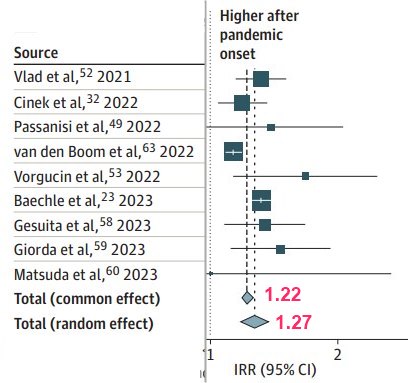T1 Diabetes increased by 27% by second year of COVID – meta-analysis
Incidence of Diabetes in Children and Adolescents During the COVID-19 Pandemic – A Systematic Review and Meta-Analysis
JAMA Netw Open. 2023;6(6):e2321281. doi:10.1001/jamanetworkopen.2023.21281
Daniel D’Souza, BHSc1; Jessica Empringham, MD2; Petros Pechlivanoglou, PhD1,3; et alElizabeth M. Uleryk, MLS4; Eyal Cohen, MD, MSc1,2,3,5; Rayzel Shulman, MD, PhD1,2,3,6

Key Points
Question Was there a change in the incidence of diabetes in children and adolescents after the onset of the COVID-19 pandemic?
Findings In this systematic review and meta-analysis of 42 studies including 102 984 youths, the incidence of type 1 diabetes was higher during the COVID-19 pandemic compared with before the pandemic.
Meaning The findings suggest the need to elucidate possible underlying mechanisms to explain temporal changes and increased resources and support for the growing number of children and adolescents with diabetes.
Importance There are reports of increasing incidence of pediatric diabetes since the onset of the COVID-19 pandemic. Given the limitations of individual studies that examine this association, it is important to synthesize estimates of changes in incidence rates.
Objective To compare the incidence rates of pediatric diabetes during and before the COVID-19 pandemic.
Data Sources In this systematic review and meta-analysis, electronic databases, including Medline, Embase, the Cochrane database, Scopus, and Web of Science, and the gray literature were searched between January 1, 2020, and March 28, 2023, using subject headings and text word terms related to COVID-19, diabetes, and diabetic ketoacidosis (DKA).
Study Selection Studies were independently assessed by 2 reviewers and included if they reported differences in incident diabetes cases during vs before the pandemic in youths younger than 19 years, had a minimum observation period of 12 months during and 12 months before the pandemic, and were published in English.
Data Extraction and Synthesis From records that underwent full-text review, 2 reviewers independently abstracted data and assessed the risk of bias. The Meta-analysis of Observational Studies in Epidemiology (MOOSE) reporting guideline was followed. Eligible studies were included in the meta-analysis and analyzed with a common and random-effects analysis. Studies not included in the meta-analysis were summarized descriptively.
Main Outcomes and Measures The primary outcome was change in the incidence rate of pediatric diabetes during vs before the COVID-19 pandemic. The secondary outcome was change in the incidence rate of DKA among youths with new-onset diabetes during the pandemic.
Results Forty-two studies including 102 984 incident diabetes cases were included in the systematic review. The meta-analysis of type 1 diabetes incidence rates included 17 studies of 38 149 youths and showed a higher incidence rate during the first year of the pandemic compared with the prepandemic period (incidence rate ratio [IRR], 1.14; 95% CI, 1.08-1.21). There was an increased incidence of diabetes during months 13 to 24 of the pandemic compared with the prepandemic period ( IRR, 1.27 ; 95% CI, 1.18-1.37). Ten studies (23.8%) reported incident type 2 diabetes cases in both periods. These studies did not report incidence rates, so results were not pooled. Fifteen studies (35.7%) reported DKA incidence and found a higher rate during the pandemic compared with before the pandemic (IRR, 1.26; 95% CI, 1.17-1.36).
Conclusions and Relevance This study found that incidence rates of type 1 diabetes and DKA at diabetes onset in children and adolescents were higher after the start of the COVID-19 pandemic than before the pandemic. Increased resources and support may be needed for the growing number of children and adolescents with diabetes. Future studies are needed to assess whether this trend persists and may help elucidate possible underlying mechanisms to explain temporal changes.
📄 Download the PDF from VitaminDWiki
Many might have to have daily insulin for life - Dr. Campbell Substack and YouTube
YouTube July 4, 2023 20 minutes
VitaminDWiki - studies in both categories Diabetes and Virus
This list is automatically updated
{category}
VitaminDWiki – Overview Diabetes and vitamin D contains
{include}
65+ VitaminDWiki Diabetes pages with T1 or TYPE 1 in title
This list is automatically updated
{LIST()}
This increase in T1 may be due to COVID's deactivation of Vitamin D Receptor
COVID protects itself by deactivation of the VDR.
COVID probably fails to re-activate the VDR when it leave the body
Excess deaths - 5 possible reasons - many studies
primary suspect: deactivation of Vitamin D Receptor
There are studies in bothVirus and Vitamin D Receptor categories
Type 1 diabetes 1.6 times more likely if a Vitamin D Receptor problem – Feb 2017
Type 1 Diabetes association with poor Vitamin D Receptor: 39 studies – April 2017
VitaminDWiki COVID infections and vaccinations decrease Vitamin D – many studies
{include}
See also web
Could the development of COVID-19 vaccine-induced type 1 diabetes be explained by a simple mechanism? - july 2022 -doi: [10.1016/j.diabet.2022.101338] FREE PDF
Vaccine-induced autoimmunity: the role of molecular mimicry and immune crossreaction - June 2018 https://doi.org/10.1038/cmi.2017.151 FREE PDF
Vaccines and the risk of insulin-dependent diabetes (IDDM): potential mechanism of action - Nov 2001 DOI: 10.1054/mehy.2001.1352 FREE PDF
